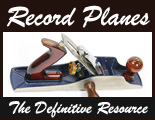Some Hand Plane Making Tips From Bill Carter
Following on from our interview with British hand plane maker Bill Carter, Bill has given Handplane Central a few of his tips and tricks that he has discovered over the years while making infill and wooden hand planes.
On keeping things in their place:
What I tend to do with planes is Araldite the infill first, once it’s fitted, and leave that overnight before I drill the rivet holes. That way everything is held in place and you don’t have to worry about clamps loosening off while you’re drilling.
On truing beds:
Although I don’t use floats, I have a wonderful tip that i’ve never, ever seen mentioned in any book or magazine. Get a normal woodworking chisel – any width – and heat it up to cherry red, then quench it. The chisel then becomes exceptionally hard and it will even cut steel. If you then grind the end of it to make it ninety degrees it will scrape timber like nothing else. It won’t dig in, but it will remove high spots like they weren’t even there – it’s fantastic. It’s much easier to use than both a chisel or a float, and even though I have several floats I don’t use them because I find these modified scraping chisels so useful.
On antiquing:
For darkening brass and boxwood dunk them in a mixture of oak shavings and ammonia, then leave them for a few minutes. You can also fume boxwood by suspending it in a jar above a mixture of nitric acid with a piece of copper in it – even a copper coin will do. The jar will quickly fill with black fumes so seal it carefully with aluminium foil. Potassium crystals and water can be used for aging bronze and gunmetal, and gun blue can be used to age steel by simply rubbing it on. You will also have to neutralise the finished planes to stop the chemicals from continuing to work. In most cases wash the planes in water with a little baking soda added. It’s also important to realise that any acid can be dangerous as well as any fumes they produce, so take the appropriate precautions into consideration.
NOTE: Since first doing this interview in the late 1990’s, Bill now has his own website full of information and images of his work. You can find Bill Carter’s website here.






